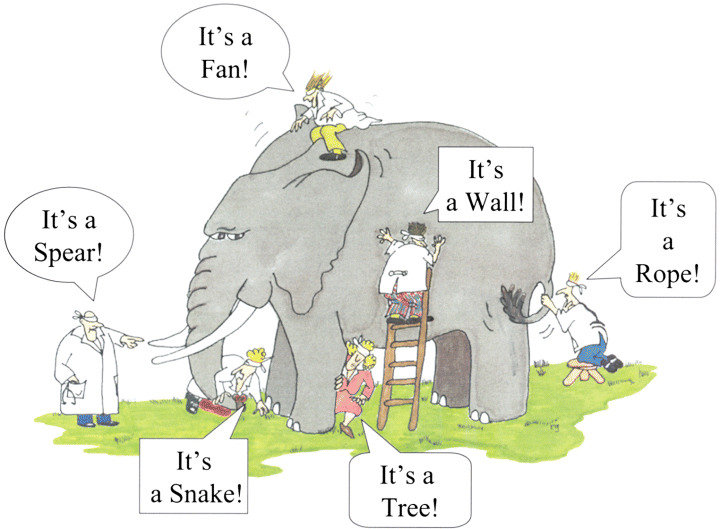What is that thing on the Internet, and is it bad?
When talking about Internet assets we often confuse “What is it?”, “Is it bad?” and “What should I do about it?”. This write-up intends to show why it is important to keep those questions and answers to them separate.

Figure 1: The Shape of the Elephant
Post 27 of #100DaysToOffload https://100daystooffload.com/
1 Questions to ask
When identifying Internet-based assets, there are a series of basic questions1 that need to answered:
- What is it?
- How do I know?
- How certain am I?
- Is it “bad”?
- depends on who you are
- depends on time
- What can I do about it?
2 An Example: Web servers serving pages with flash
One example can be used to illustrate the point: web servers serving content with Adobe Flash (https://en.wikipedia.org/wiki/Adobe_Flash).
Flash is an older web technology that has known security vulnerabilities, is deprecated (Adobe to stop supporting it on 12/31/2020) and has been replace by HTML5.
Let’s classify it using the questions above, assuming we have scanned a web site and pulled back the HTML body of the main page via an HTTP GET request:
- What is it?
- A web server serving pages with flash.
- How do I know?
- We see files with
.swfextensions embedded in javascript returned as part of the web page, e.g.
var swfpath="/e/data/images/pixviewer.swf
- How certain am I?
- Your signatures may vary. There are other strings you can look for such as:
application/x-shockwave-flash
http://www.macromedia.com/go/getflashplayer
You might start with a google search for
intext:http://www.macromedia.com/go/getflashplayer
It’s just a question of how much time you want to put into developing the signature. For some things (HTML) there is a lot of ambiguity. For others (TCP, HTTP, SNMP, SSH…) the protocol will not work if the transactions are not well defined. Identification of less well defined protocols is ad hoc based on heuristics. Identification of well defined protocols is more certain. See below.
- Is it “bad”? It depends.
- Once we’ve answered the “what is it”
question, you can begin to address the “is it bad” question and
possibly it’s corollary “how bad is it?” (not addressed here).
Lets return to our flash example. It turns out Chinese web sites
are a large current (2020-09-17) source of flash on the web. A
security products vendor also uses a lot of flash on their login
page.
-
‘Is it bad?’ depends on who you are
- Chinese government? Maybe you WANT people to download vulnerable software to enhance your ability to monitor citizens activity.
- Chinese human rights activist? You probably don’t want known vulnerable software on your computer.
- Security vendor? Forcing your security minded customers to download and run known vulnerable software as part of logging into your security web site is, at best, bad form.
-
‘Is it bad?’ “Is it bad” “depends on time When did vulnerabilities in the product become widely known (e.g. a CVE published)? When was “proof of concept” exploit code available? When are/were patches/upgrades available? …
-
‘Is it bad?’ depends on where you are Are you at work on a laptop supplied by your employer who has a policy against accessing web sites that use flash? Are you at home or in a lab doing web vulnerability research on a “throwaway” machine…
-
- What can I do about it?
- Lastly, and probably most importantly, the question is “What can I do about it?”. Are there steps I can/should take to fix things that are “bad”? Patch? Upgrade? Choose a different security vendor…?
3 Keep each issue separate, think about them independently
It is important to keep the answers to these questions separate. For instance saying “write some software to find bad things on web servers” presupposes a common definition of “bad”, which, as we’ve seen above can be highly contextual.
It would be far better to keep them separate. For instance, define a taxonomy (see below) to say “what is this”? Then separately devise ways to answer the “is it bad” question for separate environments (countries, organizations, individuals …)
4 Taxonomies, Ontologies and ASCII Art, Oh My !!!
The outline above lists the basic questions. It is possible that there will be a need for a deeper dive/more complete classification. For instance, revisiting what is it? for the web server with flash, we might come up with this taxonomy:
+ open port WELL DEFINED, CERTAIN IDENTIFICATION
+ tcp
+ tls ^
+ web server |
+ microsoft |
+ iis |
+ 7.3 |
+ services |
+ flash v
+ frameworks
+ dotnet LESS DEFINED, LESS CERTAIN IDENTIFICATION
Taxonomies help in classifying, understanding and communicating about things, for instance taxonomies (and Latin names) have been used in Biology for hundreds of years. More recently, the cybersecurity world started standardizing vulnerability naming as CVE.
5 Conclusion
When thinking about Internet assets, writing software to detect and classify/fingerprint assets and deciding what to call “bad”, keep the preceding questions in mind and try to keep the questions separate.
6 Disclaimer
The opinions expressed here are mine, and not those of my employer. In fact, they may not even be mine. I may have changed my mind. I may have grown beyond a particular opinion. I may be trolling you. I may be engaging in Socratic dialog to tear down your beliefs. I may be tearing down my own beliefs. γνῶθι σεαυτόν!
-
Note that these are not randomly chosen questions. They map fairly directly to some of the basic questions of epistemology, morals and ethics. ↩︎